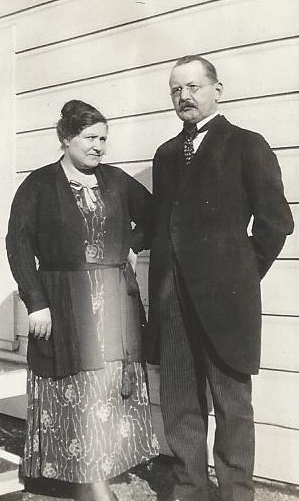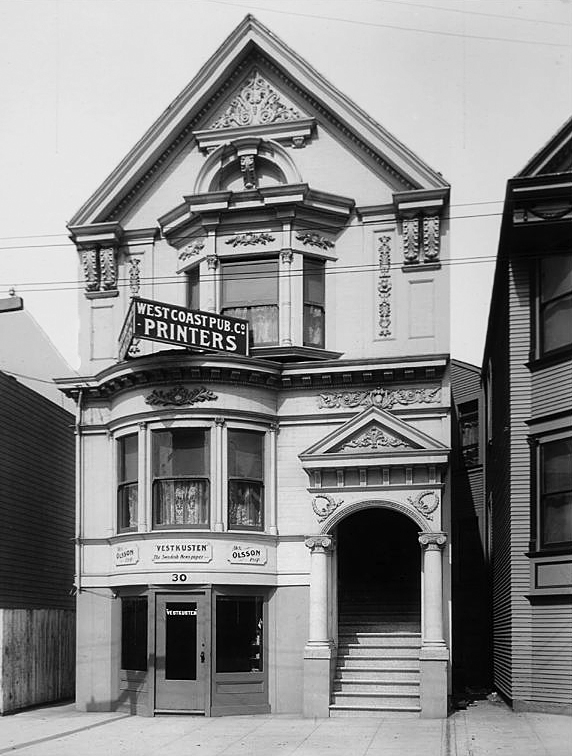Meeting Jultomten at Farfar's
Third generation Swedish American Ted Olsson reminisces over Christmases past.
-
 Augusta & Alexander Olsson at home, 1934. Photo: Ted Olsson, 2013
Augusta & Alexander Olsson at home, 1934. Photo: Ted Olsson, 2013 -
-
Alexander Olsson, publisher/editor of Vestkusten, lived at 30 Sharon Street after San Francisco’s 1906 earthquake. He bought this beautiful Edwardian home and converted the basement into his newspaper office and print shop. It was in the heart of the transplanted Swedish and Scandinavian community, and only blocks from the fire line. A decade later he would move his business a block away to Church Street at Market, then as now a major intersection. More on the Olsson family in this portrait by Muriel Nelson Beroza: The Alexander Olsson Family
To me as a little boy, Sharon Street seemed to be the center of the world, for though my immediate family lived 20 blocks from the Pacific Ocean, both sets of grandparents lived on the one block-long Sharon Street, right across the street from each other. Farfar had the newspaper; Morfar was superintendent of the newly built Swedish-American Hall at the end of the street on Market Street. My parents knew each other all their lives!
Unfortunately, by the time I was born both Morfar and Farmor had died. So, Mormor lived across the street from Farfar, where I live today, as the current custodian of the family home. -
 Photo of Alexander Olsson's Vestkusten home at 30 Sharon Street after 1906. Photo: Ted Olsson, 2013
Photo of Alexander Olsson's Vestkusten home at 30 Sharon Street after 1906. Photo: Ted Olsson, 2013 -
-
This house was almost a hotel in those early days. My grandfather’s spinster sister, Minnie, ruled the house, evidently even when Farmor was alive. His brother, John, worked as a printer at the paper and shop but lived with his wife, Adelaide (“Addie”) elsewhere. Farfar’s divorced daughter, Martha Kuhnle, herself quite influential in the community, lived at this time at the family home with her daughter, Ramona.
On the first Christmas I remember, the home was filled with family. In addition to my infant sister, Karin, there was my godfather and his family. One of his daughters was Ramona’s best friend; his other daughter, Tudy, was my age. Later I remember my godfather reaching up to light the gas jets between the already turned on electric bulbs. I still think of those days whenever I look at our transitional chandelier.
On that night all the adults were chattering about the possibility of Jultomten dropping by to see if there were any good boys and girls in the home. Never having met or even heard of this visitor, I was sure that I met his criteria, for then he would reward me with a gift. I couldn’t imagine this strange person—never described—but I could imagine the gifts that I would enjoy. Everybody seemed to be anticipating the possible arrival of this important visitor, which only built up the anxiety. Tudy, being much more mature than I, was interested but not as giddy as I was. Oh, how long it would take to get through the Julbord, and everybody at the table chattering about so many unimportant topics! We had even had dessert and left the table for the living room and this Jultomten still hadn’t arrived. Maybe I didn’t qualify? Still, Tudy and I kept running to peer out the front windows to see if there was any trace of him (his abrupt visit was the only thing I knew about Jultomten; no mention of his kindness, mischievousness nor dwarfishness). -
 Ernst Skarstedt and Alexander Olsson at the Vestkusten's earlier Office, 1895. Skarstedt, one of Swedish America’s most prolific writers spent time at Vestkusten between 1891 and 1896. In later years he became the editor of Nordstjernan, climbing the steps of the legendary office on Park Row, New York City, for six years between 1920 and 1926.
Ernst Skarstedt and Alexander Olsson at the Vestkusten's earlier Office, 1895. Skarstedt, one of Swedish America’s most prolific writers spent time at Vestkusten between 1891 and 1896. In later years he became the editor of Nordstjernan, climbing the steps of the legendary office on Park Row, New York City, for six years between 1920 and 1926. -
So, when the doorbell finally rang, I only just beat Tudy to the front door. I opened the door to meet Jultomten. I had the justification of my behavior all memorized. But standing there before me laughing, with a great white beard and hunched over in his red suit with his big stuffed bag, was this Jultomten: a truly scary sight to this very little boy. My reasons escaped me, his jarring laughter and entrance into the house as familiar as a member of the family scared the wits out of me. Even Farfar was heartily laughing.
This “unmanned” the boy of 5. I bolted to hide under the table, where I huddled quaking, with the whole room now joining Jultomten in his laughter. When the boots asked if there were any good children here, I certainly didn’t volunteer. Nor did I extend my hand by way of introduction. All I remember of Jultomten at that initial meeting were his black boots. I don’t even remember what, if anything, he left me (it might have even been a lump of coal).
Suffice it to say that in future years, after I had seen pictures of Jultomten and learned more about this character, I gained tremendous courage. On reflection now it’s ironic that such a thin, dapper man as Uncle John could have seemed so large in height and girth.
Later years are more memorable to me as all of the family would gather at Farfar’s. He only lived until I was ten but I cherish that twinkle in his eye and his mischievous laugh, as, settled into his deep easy-chair, a lamp beside him to read his paper or a book, he took time to talk to his growing little grandson while presenting him with the paper ring from his cigar.
At this time of year, memories of meeting Jultomten at Farfar’s home—our home— begin about advent, when we decorate the home in all of its Swedish accents. -
“God Jul och Gott Nytt År!”
Ted Olsson
San Francisco -
-
